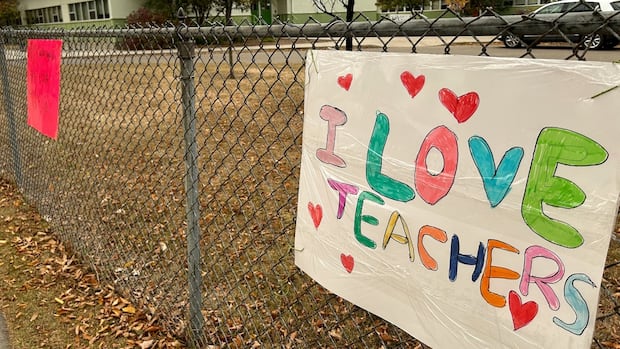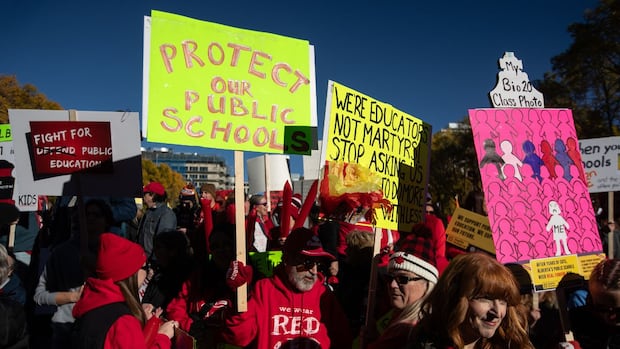School doors across Alberta were shuttered Monday after 51,000 teachers walked off the job after the association representing them was unable to reach an agreement with employers that teachers would accept.
It was not a step teachers wanted to take but one they see as necessary, Alberta Teachers’ Association (ATA) president Jason Schilling said at a Monday morning news conference.
“Our classrooms, hallways and school fields are empty, and not because we’ve given up on public education but because we care too much about it to stand by and watch it slowly erode and crumble from chronic underfunding,” Schilling said.
This is the first provincewide teachers’ strike in Alberta’s history.
Alberta Finance Minister Nate Horner in a written statement called on the association to return to the bargaining table.
“This is a sad day for our province,” Horner’s statement said.
More than 750,000 students across Alberta’s public, Catholic and francophone schools are affected by the strike and class cancellations.
A statement from the finance minister’s office said the Alberta government has no plans to reconvene the legislature early to table back-to-work legislation for teachers. The next session is scheduled to begin Oct. 23.
The statement said the government would like to see teachers and their employers reach a deal at the bargaining table.
Schilling said the ATA is in “exploratory talks” with the Teachers Employer Bargaining Association, which negotiates on behalf of the province and Alberta’s 61 school boards.

School boards have told students’ families not to drop children off at school buildings or take them to bus stops. With a lack of clarity about how long a strike might last, school divisions last week told parents and guardians to bring home any student belongings that might be needed.
The provincial government is offering $30 per day per child to families of children age 12 and younger whose classes are cancelled during the strike.
The government will increase the monthly child-care subsidy for children in Grades 1 to 6 to summer rates if the strike lasts longer than five days, it said in a Friday news release.
The province has also posted an online toolkit of lessons for students, and is lifting a cap on distance education credits, the government said Friday. The province is also waiving entrance fees for people age 18 and younger at provincial cultural sites, such as the Royal Alberta Museum in Edmonton and Head-Smashed-in Buffalo Jump near Fort Macleod.
The government is also offering families who switch their children to home schooling part of the annual funding available for supplies. However, they say there is no guarantee that any student who leaves a public, Catholic or francophone school for home schooling, a charter or a private school will be able to get back into their original school when the strike ends.
Schilling said some teachers have raised concerns about the toolkit, which uses mostly American resources and some of which introduce concepts younger children aren’t yet familiar with.
Support for educators
Tens of thousands of people gathered at the Alberta legislature and other sites across the province on Sunday in support of teachers.

On Monday morning, Edmonton parent Matthew Field dropped his son off for a full day of day care instead of his usual Grade 1 class. Field said he has flexible work hours and their child-care centre were able to take children for full days during the strike, so he considers his family lucky.
Field said his son is a high-needs student. and he’s been surprised by how the amount of support has eroded, just in the past two years.
“It’s really unfortunate. The teachers want better, the support staff want better, the parents want better,” he said.
Edmontonian Charlie McKnight doesn’t have kids in school, but says he’s “disgusted” by the provincial government spending money on advertising campaigns in the teacher contract dispute while saying they don’t have money to increase education funding.
“I think there’s lots can be done if the government actually had true resolve to solve the problem,” he said.
Classroom conditions and pay at issue
The contract between 51,000 teachers and their employers expired on Aug. 31, 2024. Tensions escalated in May when teachers voted to reject a mediator’s proposal that would have seen wages increase 12 per cent over four years, and create a $405 million class size and complexity fund.
A month later, ATA members voted 94.5 per cent in favour of a strike, which put them in a legal strike position for 120 days, until Oct. 7.
The ATA said on Sept. 10 members would go on strike on Oct. 6 if the parties couldn’t reach a deal by that deadline.
The parties reached a tentative agreement with the same 12 per cent salary increase and a government promise to pay for 3,000 net new teachers and 1,500 more educational assistant positions by 2028. The government said the offer would have been worth $2.6 billion over four years.
In a vote last week with 94 per cent turnout, nearly 90 per cent of teachers rejected that offer, setting the stage for a walkout.
Some teachers said the offer failed to address their concerns about salaries not keeping up with inflation, which makes teacher recruitment and retention more difficult. They also said 3,000 teachers over three years is not enough to improve deteriorating conditions in classrooms, where enrolment continues to grow and overwhelmed teachers feel they can’t meet students’ diverse needs.
After a months-long contract dispute between teachers and the province, 51,000 members of the Alberta Teachers’ Association went on strike Monday morning. The union voted overwhelmingly against a contract offer last week.
Last week, Schilling says the province’s schools need at least 5,000 more teachers to meet provincial class size recommendations.
Premier Danielle Smith has said the government won’t agree to class-size caps because the province doesn’t have enough space in schools.
Schilling said Monday that other provinces with class-size caps and complexity ratios in their collective agreements have found ways for additional teachers to add improve education even without additional space.
“We’re supposed to teach classes in overcrowded spaces because the government failed to plan,” Schilling said. “It sounds like an excuse to me.”
The ATA says informal conversations are taking place with the government in hopes of finding future terms of agreement.








